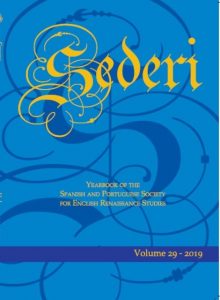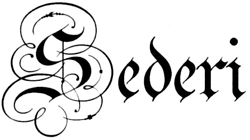
Sederi 29
Sederi 29 — 2019
EDITOR
Ana Sáez-Hidalgo
MANAGING EDITOR
Keith Gregor
REVIEW EDITOR
María José Mora
ISSN 1135-7789
Sophie Chiari, “The limner’s art in Shakespeare’s Macbeth.” SEDERI 29 (2019): 61–83.
DOI: https://doi.org/10.34136/sederi.2019.3 Download PDF
Abstract
Macbeth is a graphic work whose visual rhetoric mirrors the outside atmosphere of the Scottish heath and the inner psyche of the titular characters. This article explores the early modern visual praxis in Macbeth in connection with the art of limning to show that, against a dark background symbolizing evil, the playwright uses golden and gaudy hues as a mirror reflecting Macbeth’s perturbed mind. Eventually, the colour spots in the play are “diapered over” by the white fog of the Scottish heath. Shakespeare thus resorts to specific colour codes in order to create a visual symphony where “foul” becomes “fair.”
Keywords: Macbeth; limning; miniature; Nicholas Hilliard; Isaac Oliver.
References
A Very Proper Treatise, Wherein Is Briefly Sett Forthe the Arte of Limming. 1573. London: Imprinted by Richard Tottill [sic]. STC (2nd ed.) 24252.
Artaud, Antonin. 1993. The Theatre and its Double. Translated by Victor Corti. London: Calder.
Ascham, Roger. 1570. The Scholemaster. London: Printed by John Daye. STC (2nd ed.) 832.
Batman, Stephen. 1582. Batman vppon Bartholome His Booke De proprietatibus rerum, Newly Corrected, Enlarged and Amended. London: Printed by Thomas East. STC (2nd edition) 1538.
Beal, Peter. 2008. A Dictionary of English Manuscript Terminology 1450–2000. Oxford: Oxford University Press.
Bradley, A.C. 2004. “On the Effects of Darkness.” In William Shakespeare’s Macbeth, Bloom’s Guides. Comprehensive Research & Study Guides, edited with an Introduction by Harold Bloom, 50–52. Broomall: Chelsea House Publishers.
Braunmuller, Albert R., ed. 2001. William Shakespeare, Macbeth. Cambridge: Cambridge University Press.
Bredekamp, Horst. 2015. Der Bildakt. Berlin: Wagenbach.
Chiari, Sophie. 2018. “Shakespeare’s Poetics of Impurity: Spots, Stains and Slime.” Études Épistémè 33 (special issue: Profane Shakespeare—Perfection, Pollution and the Truth of Performance). Accessed March 26, 2019. https://journals.openedition.org/episteme/2164.
Clark, Sandra, and Pamela Mason, eds. 2015. William Shakespeare, Macbeth. The Arden Shakespeare. London: Bloomsbury.
Cole, Lucinda. 2016. Imperfect Creatures: Vermin, Literature, and the Sciences of Life, 1600–1740. Ann Arbor: University of Michigan Press.
Colie, Rosalie. 1974. Shakespeare’s Living Art. Princeton: Princeton University Press.
Coombs, Katherine. 2009. “‘A Kind of Gentle Painting’: Limning in 16th–Century England.” In European Visions: American Voices, edited by Kim Sloan, 77–84. London: British Museum Press.
Costa de Beauregard, Raphaëlle. 1991. Nicholas Hilliard et l’imaginaire élisabéthain: 1547–1619. Paris: Éditions du CNRS.
Costa de Beauregard, Raphaëlle. 2015. “‘Medieval’ and ‘Modern’ Conceptions of the Colours of Light in Early Modern England and Isaac Oliver’s Portrait Miniatures.” E-rea 12 (2) (special issue: “The Dyer’s Hand”: Colours in Early Modern England, edited by Sophie Chiari). Accessed March 26, 2019. https://journals.openedition.org/erea/4348.
De Sousa, Geraldo U. 2016. At Home in Shakespeare’s Tragedies. New York: Routledge.
Deng, Stephen. 2011. Coinage and State Formation in Early Modern English Literature. New York: Palgrave Macmillan.
Drakakis, John. 2013. “Introduction.” In Macbeth: A Critical Reader, edited by John Drakakis and Dale Townshend, 1–17. London: Bloomsbury.
Dulac, Anne-Valérie. 2015. “The Colour of Lustre: Limning by the Life.” E-rea 12 (2) (special issue: “The Dyer’s Hand”: Colours in Early Modern England, edited by Sophie Chiari). Accessed March 26, 2019. https://journals.openedition.org/erea/4402.
Elam, Keir. 2017. Shakespeare’s Pictures. Visual Objects in the Drama. London: Bloomsbury.
Fernie, Ewan. 2015. “Another Golgotha.” In Shakespeare and Early Modern Religion, edited by David Loewenstein and Michael Witmore, 172–90. Cambridge: Cambridge University Press.
Fletcher, Giles. 1593. “Galatea.” In Licia, or Poemes of Loue in Honour of the Admirable and Singular Vertues of His Lady. Cambridge: Printed by John Legat. STC (2nd ed.) 11055. 58.
Fumerton, Patricia. 1991. Cultural Aesthetics: Renaissance Literature and the Practice of Social Ornament. Chicago: The University of Chicago Press.
Garrison, Cheryl. 2009. Iron Disorders Institute Guide to Anemia. Naperville. Illinois: Cumberland House.
Goggin, Maureen Daly. 2012. “The Extra-Ordinary Powers of Red in Eighteenth- and Nineteenth-Century English Needlework.” In The Materiality of Color. The Production, Circulation and Application of Dyes and Pigments, 1400–1800, edited by Andrea Feeser, Maureen Daly Goggin, and Beth Fowkes Tobin, 29–44. London: Routledge.
Gurr, Andrew, and Mariko Ichikawa. 2002. Staging in Shakespeare’s Theatres. Oxford: Oxford University Press.
Harris, Jonathan Gil. 2009. Untimely Matter in the Time of Shakespeare. Philadelphia: University of Pennsylvania Press.
Hobgood, Allison P. 2013. “Feeling Fear in Macbeth.” In Shakespearean Sensations. Experiencing Literature in Early Modern England, edited by Katharine A. Craig and Tanya Pollard, 29–46. Cambridge: Cambridge University Press.
Hobgood, Allison P. 2014. Passionate Playgoing in Early Modern England. Cambridge: Cambridge University Press.
Holinshed, Raphael. 1978. The Chronicles of England, Scotlande, and Ireland (1587 edition). In Narrative and Dramatic Sources of Shakespeare, edited by Geoffrey Bullough, 8 vols, vol. 7, 478–508. London: Routledge and Kegan Paul; New York: Columbia University Press.
Jacobson, Miriam. 2015. “Learning to Colour in Hamlet.” In Shakespeare’s World of Words, edited by Paul Yachnin, 103–24. London: Bloomsbury.
Jones, Ann Rosalind, and Peter Stallybrass. 2003. Renaissance Clothing and the Materials of Memory. Cambridge: Cambridge University Press.
Jones, Gwilym. 2015. Shakespeare’s Storms. Manchester: Manchester University Press.
Joyce, James. 1986. Ulysses, edited by Hans Walter Gabler, Wolfhard Stepe, and Claus Melchior. New York: Random House.
Judge, Harry George, and Anthony Toyne. 1990. Oxford Illustrated Encyclopedia: The Arts, 9 vols., vol. 5. Oxford: Oxford University Press.
Karim-Cooper, Farah, and Lucy Munro. 2006. “Conclusions and Findings.” In Shakespeare’s Globe Theatre History Seminar. Stage Blood: A Roundtable, edited by Farah Karim-Cooper and Ryan Nelson, 23–24. London: Shakespeare’s Globe. Accessed 10 September 2019. https://issuu.com/bedeabza/docs/999977.
Karim-Cooper, Farah, and Ryan Nelson. 2006. “Proceedings.” In Shakespeare’s Globe Theatre History Seminar. Stage Blood: A Roundtable, edited by Farah Karim-Cooper and Ryan Nelson, 3–4. London: Shakespeare’s Globe. Accessed 10 September 2019. https://issuu.com/bedeabza/docs/999977.
Kinney, Arthur F., ed. 1983. Nicholas Hilliard’s Art of Limning. Boston: Northeastern University Press.
Kranz, David L. 2003. “The Sounds of Supernatural Soliciting in Macbeth.” Studies in Philology 100 (3): 346–83.
Laroque, François. 1993. “Macbeth: Theatre of Image.” In Spectacle & Image in Renaissance Europe, edited by André Lascombes, 147–76. Leiden: E.J. Brill.
Lecercle, Ann. 1987. “Mannerist Macbeth: Between Medusa and Maccabee.” In Miroirs de l’être: Macbeth, The Man of Mode, edited by Jean-Paul Debax and Yves Peyré, 69–94. Toulouse: Presses Universitaires du Mirail.
Leggatt, Alexander, ed. 2006. William Shakespeare’s Macbeth. A Sourcebook. London: Routledge.
Lodge, Thomas. 1596. A Margarite of America. London: Printed for John Busbie. STC (2nd ed.) 16660.
Lomazzo, Giovanni Paolo. 1598. A Tracte Containing the Artes of Curious Paintinge Caruinge Building. Translated by Richard Haydock. Oxford: Printed by Joseph Barnes. STC (2nd ed.) 16698.
Marr, Alexander. 2016. “Visual Arts.” In The Cambridge Guide to the Worlds of Shakespeare. Shakespeare’s World, 1500–1660, edited by Bruce R. Smith, 2 vols., vol. 1, 375–87. Cambridge: Cambridge University Press.
Middleton, Thomas. 1613. The Triumphs of Truth. London: Nicholas Okes.
Mullan, John. 2016. “Conjuring Darkness in Macbeth.” Discovering Literature: Shakespeare and Renaissance. British Library Website. Accessed March 26, 2019. https://www.bl.uk/shakespeare/articles/conjuring-darkness-in-macbeth.
Murray, W.A. 1966. “Why Was Duncan’s Blood Golden?” Shakespeare Survey 19, Macbeth, edited by Kenneth Muir): 34–44.
Norgate, Edward. 1919. Miniatura or the Art of Limning (c. 1627). Edited from the manuscript in the Bodleian Library and collated with other manuscripts by Martin Hardie. Oxford: Clarendon Press.
Osborne, Robin, and Jeremy Tanner, ed. 2007. Art’s Agency and Art History. Malden (MA), Oxford and Victoria: Blackwell Publishing.
Peacham, Henry. 1606. The Art of Drawing with the Pen, and Limming in Water Colours. London: Printed by Richard Braddock for William Jones. STC (2nd ed.) 19500.
Peacham, Henry. 1612. The Gentlemans Exercise. London: Printed for John Browne. STC (2nd ed.) 19508.
Pedretti, Carlo, ed. 1964. Leonardo Da Vinci on Painting: A Lost Book (Libro A). Berkeley: University of California Press.
Pollard, Tanya. 2005. Drugs and Theater in Early Modern England. Oxford: Oxford University Press.
Sabatier, Armelle. 2017. Shakespeare and Visual Culture. A Dictionary. London: Bloomsbury.
Salkeld, Duncan. 2018. Shakespeare and London. Oxford: Oxford University Press.
Smith, Emma. 2013. Macbeth: Language and Writing. London: Bloomsbury.
Smith, Pamela H. 2016. “Itineraries of Materials and Knowledge in the Early Modern World.” In The Global Lives of Things. The Material Culture of Connections in the Early Modern World, edited by Anne Gerritsen and Giorgio Riello, 31–61. New York: Routledge.
Sokol, B.J. 2018. Shakespeare’s Artists: The Painters, Sculptors, Poets and Musicians in his Plays and Poems. London: Bloomsbury.
Taylor, Gary, John Jowett, Terri Bourus, Gabriel Egan, eds. 2016. The New Oxford Shakespeare. The Complete Works. Modern Critical Edition. Oxford: Oxford University Press.
Taylor, John. 1618. The Pennyles Pilgrimage. London: Printed by E. Allde.
Wilde, Carolyn. 1987. “Painting, Expression, Abstraction.” In Philosophy and the Visual Arts. Seeing and Abstracting, edited by Andrew Harrison, 29–50. Dordrecht: D. Reidel Publishing Company.
